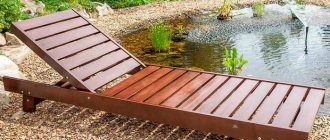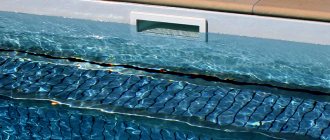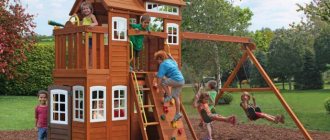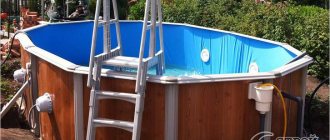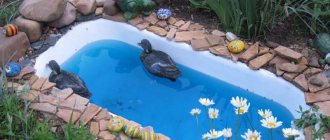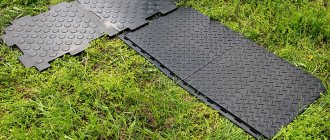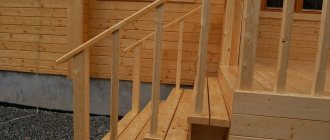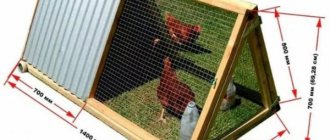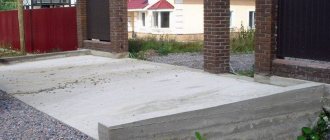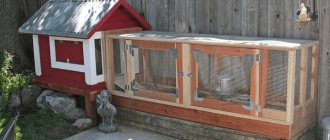Articles
All photos from the article
Previously, wooden flooring was made at the dacha with your own hands directly from an ordinary edged board, since there were simply no other options. However, more efficient materials have now emerged, made from the most sustainable tree species. Most often, larch, oak or beech are used as the main raw materials.
The photo shows the street deck next to the main structure.
Design solutions for a summer residence: types of rubber tiles
There are several different types of rubber yard surfacing available on the market. It comes not only in different thicknesses and geometric shapes, but also in all kinds of colors.
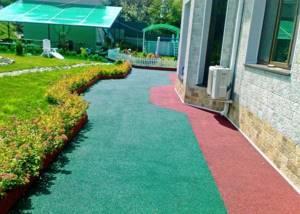
This is the latest trend in landscape design.
You can cover the courtyard area and pave rubber paths using the following types of tiles:
- Standard square. Most often this size is 50 * 50 cm and 33 * 33 cm, thickness - from 1 to 4 cm. The front side can be either smooth or embossed with various three-dimensional patterns.
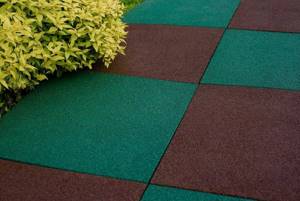
Rubber tiles are a coating made from crushed rubber (crumb rubber) and polyurethane binder glue.
- Paving stones. Tiles of various shapes (bone, timber, coil, brick, etc.), 2-4 cm thick. The surface is smooth or textured.
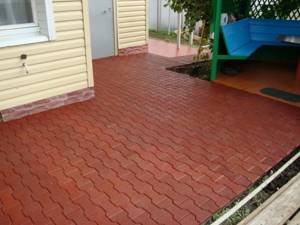
Rubber paving stones are considered a relatively new solution in the domestic building materials market.
- Ribbon. Rolled rubberized tape tracks up to 10 m long, 30 to 50 cm wide.
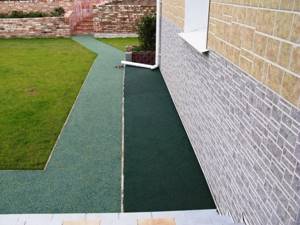
Laying rubber surfacing on playgrounds and garden paths has become popular due to its speed and ease of operation.
The specific type of coating is selected based on the overall design and layout of the site, as well as the intended purpose.
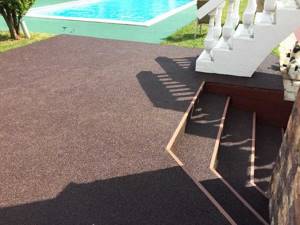
Depending on the crushed rubber fraction used, it is possible to produce coatings with different textures.
Choosing suitable timber
For the construction of platforms, standard boards are used, having the following dimensions:
- 50 x 75 mm;
- 50 x 100 mm;
- 50 x 150 mm.
Excellent effects can be achieved by using strips of the same width, or by alternating boards of different widths.
Experienced craftsmen do not recommend using boards with a width of 200 mm for equipping platforms, since they do a poor job of draining water. Moisture is retained on their surface, which contributes to warping of the wood.
You should not use bars with dimensions of 50 x 50 mm for this purpose, which are subject to curling and deformation.
The most suitable boards for making decks are 50 x 100 mm and 50 x 150 mm, laid parallel to the sides of the base platform. The strength of such flooring is the most reliable.
To make platforms, various types of wood are used, which can be:
- Coniferous. Wood from pine, smereka, and common spruce.
- Deciduous. Wood of alder, aspen, modrina.
First, the boards from which the flooring is supposed to be constructed are cleared of bark. The logs are made from unmilled boards of grade 2-3 with a moisture content of about 10-12%. For the manufacture of support beams, blanks of square beams are used, the side of which is approximately 75 mm.
Regardless of what kind of wood is used, in order to extend the life of the flooring, its surface must be treated using antiseptics and moisture-repellent compounds.
By using glazes, which are available on the modern market in a wide color palette, you can implement any exterior design solutions.
To give wooden platforms greater fire resistance, their surface is additionally treated with fire retardants.
Material characteristics
The technological process for manufacturing rubber paving slabs for the yard is based on the recycling of old unnecessary car tires. Used tires are freed from the cord and then crushed, obtaining pieces of various sizes (fractions). In special mixers, crumb rubber is mixed with an adhesive polyurethane composition, adding voluminous, highly resistant pigments. Then they are poured into molds, pressed (cold or hot) and dried in ovens.
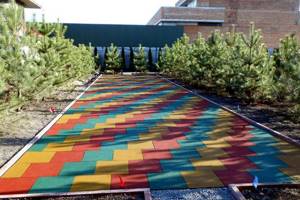
The material stands out for its advantages - environmental friendliness, durability, low cost and ease of installation.
When deciding what can be used to cover the courtyard of a private house, as well as paths and paths in the adjacent area, you should take into account a number of positive characteristics of the rubber material:
- abrasion resistance;
- density is about 850-930 cm/m3;
- high strength;
- ease of installation and repair work;
- chemical and biological resistance;
- safety from injuries (as it has a non-slip surface);
- aesthetics, thanks to a large selection of colors and textures;
- long service life (from 10 to 50 years);
- high shock-absorbing properties;
- ability to easily withstand sudden temperature changes (-45...+50 °C);
- non-fading under the influence of ultraviolet radiation;
- frost resistance (at least 300 cycles);
- non-slippery surface (ice formed in winter easily cracks);
- affordable cost;
- good moisture absorption and rapid removal (no puddles remain);
- ease of care;
- light weight and easy transportation (it is very difficult to accidentally break);
- environmental friendliness;
- non-toxic and safe.
Note! The main disadvantage of rubber tiles is the fire hazard. The material is quite flammable, so it should not be placed in a barbecue area, near a fireplace or grill, where there is an open fire.
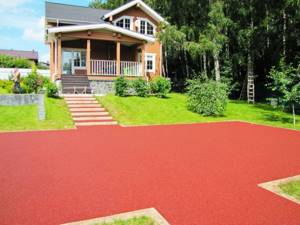
This coating can easily withstand both heat and frost.
Application of decking boards
Using these products, wooden decking for the street is actively manufactured for various purposes. With its help, floors are installed in gazebos, verandas, terraces and other open structures. Terrace boards can also be used to organize garden paths and platforms.
Explore the benefits
Initially, it is assumed that the material will be located on the street, which means that the requirements for it are noticeably increased. Some types of products undergo heat treatment, after which their resistance to the environment increases significantly.
Moisture-resistant wood is used as the base raw material.
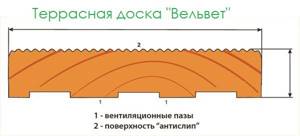
External data of similar products.
- High levels of weather resistance allow you to withstand adverse weather conditions with dignity.
- The relatively simple installation technology makes it possible to do the installation yourself.
- The aesthetic parameters of the products are very high, since natural wood is used in the production process.
- On the front surface of the elements there are special grooves 1-2 mm deep to prevent slipping.
Note! Disadvantages may include the rather high cost and the need for additional processing. Although there are products made from wood-polymer composites that do not need protection and are not very expensive.
Initial calculations
Before proceeding with the construction of the load-bearing part, a preliminary calculation of the wooden flooring should be carried out. To do this, the width is multiplied by the length, after which the resulting area is divided by the square footage of one board. This way you can find out the number of finishing elements.
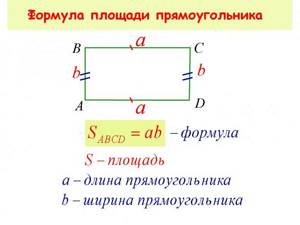
Using this formula you can find the area of a rectangular flooring.
However, for the work you will also need to purchase 100x50 mm bars, which will act as load-bearing logs. The installation step should not exceed 40 cm. The number of components can be determined if the length is divided by this distance. To the result obtained, boards are added that will be attached around the perimeter.
Load-bearing structure
Before making the flooring, it is necessary to carry out a number of preparatory work. First of all, you need to choose a place for a site, path or some other area. And already on a specific territory it is possible to construct a supporting structure from wooden blocks, as well as load-bearing slabs and blocks.
The first step is marking, for which pegs are installed at those points where the load-bearing pedestals will be located. After this, a layer of soil is removed from the support areas. Sand is poured into the bottom of the resulting pits, on which slabs or blocks are laid. They should all be on the same level.
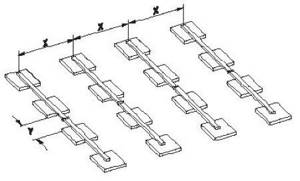
This is roughly how the logs are laid on the slabs.
A rectangular frame is knocked together from the bars, inside which the logs are located. It is laid on the surface of the supports immediately after laying the waterproofing.
Covering installation
The classic method involves the use of special fasteners. During the work process, you usually only need a medium-sized hammer and a screwdriver for tightening the screws.
That is, it is quite possible to carry out work in the absence of electricity.
- First, the boards are prepared. They are cut to size and stacked next to the installation site.
- The first strip is installed at the very edge. The fasteners are driven in at an angle of 45-60 degrees, after which they are pressed against the board. A self-tapping screw is screwed into the hole.
- The next part of the coating is fixed onto the pins with light blows of a hammer. The distance from the previous plank should not exceed 5 mm.
- The remaining boards are fastened according to the same principle until the entire area of the supporting structure is covered.
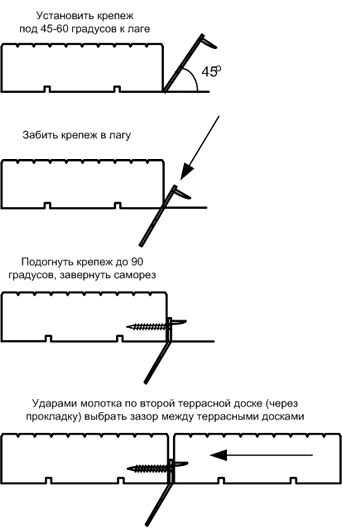
The installation process of classic fasteners.
Attention! A gap between the slats must be left to ensure high-quality ventilation, otherwise the service life of the coating will be significantly reduced.
Rubber seamless crumb coating, self-leveling
It is possible to cover a patio or pave rubber garden paths with a seamless continuous coating. It is laid according to the same principle as self-leveling floors. To prepare the working mixture, crumb rubber is used (the grain size may vary), sold by weight or packaged, and a liquid binder base, as well as various colors (coloring pigments).
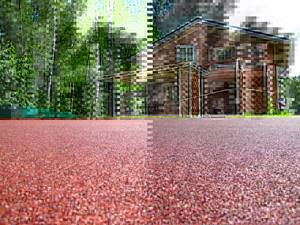
Most often, such a base is used when designing garden paths, in street garages, parking lots, children's or sports grounds, and in open courtyard areas.
The thoroughly mixed composition is applied to a previously prepared, degreased and well-dried surface, evenly distributed and leveled, then rolled and lightly compacted. After a day, when the coating has dried, it can already be used.
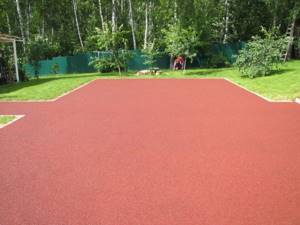
There is a bulk composition that is distributed and leveled using a roller.
The self-leveling rubber floor has no joints that can accidentally get caught. The absence of seams greatly simplifies the cleaning process, since dirt does not get clogged anywhere. Jointless rubber coating is useful for areas that have a complex configuration (near the pool, on the porch, steps, winding paths in the garden, etc.), where it is quite difficult to lay square tiles well.
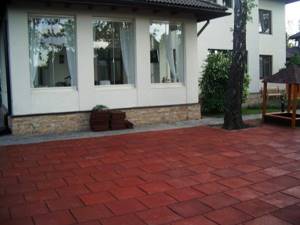
The tiles can have different shapes and configurations that imitate the paving option.
Important! To obtain a high-quality rubber seamless coating, it is necessary to mix the working composition very thoroughly.

The decoration of the yard can be done with roll or tile materials.
How to build decks with your own hands
There are a wide variety of methods used to construct wooden platforms, many of which can be done by DIYers who have only basic carpentry skills.
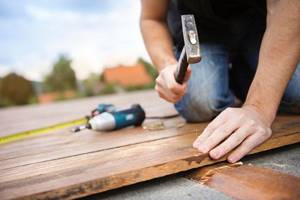
Construction of wooden platforms on a summer cottage with your own hands.
Decorative laying of tile material in the yard
Rubber tile material offers two installation options:
- on compacted soil;
- on a solid base.
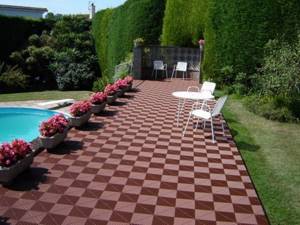
Rubber tiles can be used to create a unique pattern in your yard.
It is preferable to place rubber tiles for garden paths directly on the ground. Select a coating from 3 to 8 cm thick with special connecting sleeves that allow the elements to be fixed to each other.

For the yard or paths, rectangular or square options are often chosen.
The technology of work is as follows:
- Remove the turf with grass and the top soil layer, forming a groove 15-25 cm deep.
- Carefully compact the base of the resulting “pit”.
- Pour a crushed stone layer (5-10 cm).
- A sand cushion (5-7 cm) is placed on top.
- Level and compact well again.
- Lay out the tiles, compacting each one with a rubber hammer. There is no need to provide a slope for water drainage, since the liquid will go into the ground through the seams.
- Joints and cracks are filled with sand.
- You can use the coating immediately.
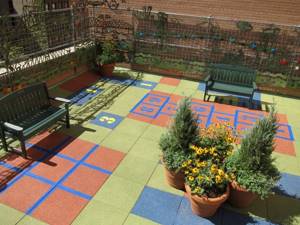
The color of the coating can also be very diverse - from classic to bright shades.
Important! If necessary, install enclosing curbs. It is better to do this in advance at the preparation stage.
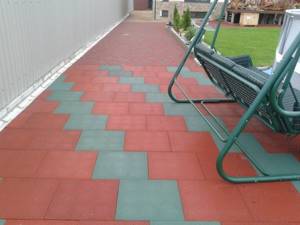
The most popular are green and burgundy shades.
A rubber track for a dacha can be mounted on a solid, usually existing wooden, concrete or asphalt base. You can use thinner tiles - from 2 cm. Work is carried out only in dry weather. The air temperature should be within +10…+20 °C, and the humidity should be about 70%.
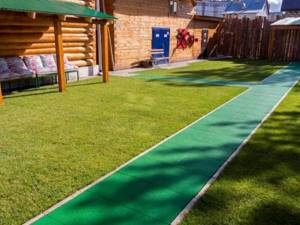
The surface of the rubber coating can be easily cleaned with running water from a hose from almost any type of contaminant.
The algorithm of actions is as follows:
- The surface is cleaned of debris, all irregularities and defects are removed, and the cracks are covered.
- Cover with primer. You can use polyurethane glue diluted in half with turpentine or any solvent (acetone).
- Using a spatula, apply two-component polyurethane glue or special mastic (rubber-bitumen). Level with a roller.
- Lay the tiles, pressing them firmly against the base and leaving as small a gap as possible between the elements. The rubber sheet is easily cut to the desired size with a jigsaw, hacksaw or knife (sharp).
- Tap with a mallet (rubber mallet), removing air bubbles.
- A slope of 2-3° is required to drain rain and melt water.
- It is permissible to walk to the laid area after two days, when the glue has completely dried.

Covering the yard with rubber tiles makes the atmosphere on the site as environmentally friendly and natural as possible.
You can lay out various patterns or ornaments from tiles of different colors (herringbone, paving stones, offset, diagonally, etc.). It is advisable to first arrange all the elements in the desired order, creating a sketch, but without fastening them together.
By using rubber coating wisely, you can decorate the yard of a private home in an unusual and practical way. If the installation technology is followed and the correct selection is made, the tile material will last for many years.
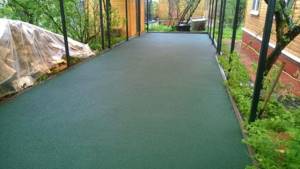
Flooring made of rubber material will not only perform a functional role, but will also become a decorative decoration of the site.
Installing support posts
When installing decks on “floating” soils, in order to increase the strength and reliability of the structure, support posts made of wood are not buried in the ground, but are installed on concrete slabs with rectangular shaped nests provided in them.
The base plates have a thickness of 15 mm. Their shape is square, with the side of the square being 400 mm. The plates are placed at equal distances from each other, the distance between them should be 1.4 meters. The distance is measured from the center of the slab.
After determining the places where the slabs and pillars will be installed, the designated areas are prepared. To do this, fertile layers of soil are removed from them, and crushed stone is poured into the resulting depressions. Concrete slabs are laid on a pre-compacted layer of crushed stone, filled with concrete mortar, and leveled.
At the same time, make sure that the slab nests are correctly positioned. They should be in line and form right angles with the nearest wall of the house.
The unused soil surface should be covered with opaque agrofibre material, which prevents the growth of weeds. To fix the non-woven fabric and consolidate the effect, the surface of the agrofibre is covered with a layer of fine gravel.
The production of support pillars is made from blanks that are made of solid beams or glued together from boards, and equipped with 7.5-centimeter spikes at the base. The posts are inserted with tenons into the sockets of the base and screwed to the concrete slabs using bolts. If the need arises, you can adjust the support posts in height - for this, the excess is sawed off.
To extend the service life of the platform, it is necessary to treat the wooden surface of the pillars using antiseptic and moisture-repellent compounds.
When installing the posts, carefully ensure that the supports located in the lowest place are not at a distance lower than the intended height of the deck. You should constantly check the surface using a building level - it must be strictly horizontal.
